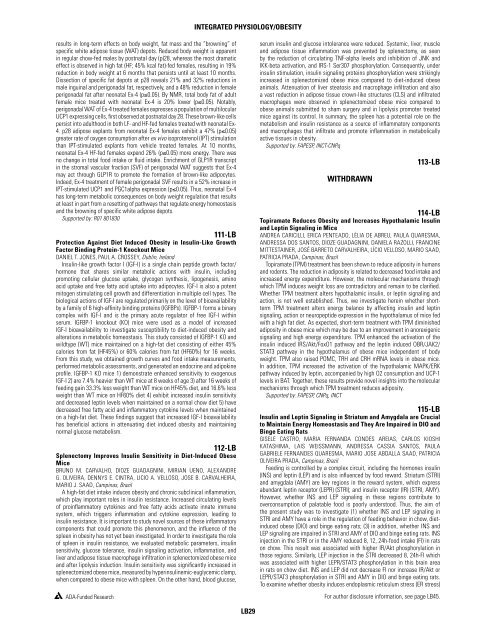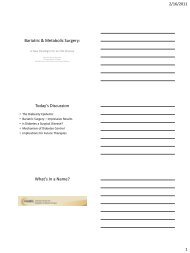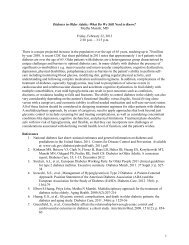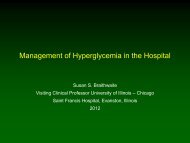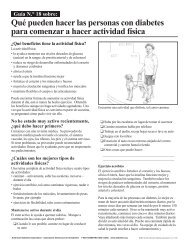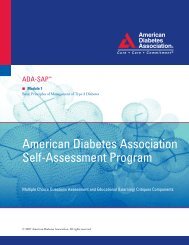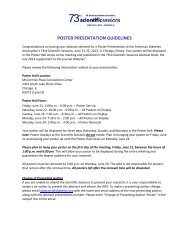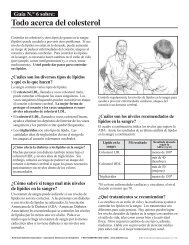A JournAl of the AmericAn DiAbetes AssociAtion
A JournAl of the AmericAn DiAbetes AssociAtion
A JournAl of the AmericAn DiAbetes AssociAtion
- No tags were found...
You also want an ePaper? Increase the reach of your titles
YUMPU automatically turns print PDFs into web optimized ePapers that Google loves.
Integrated Physiology/Obesityresults in long-term effects on body weight, fat mass and <strong>the</strong> “browning” <strong>of</strong>specific white adipose tissue (WAT) depots. Reduced body weight is apparentin regular chow-fed males by postnatal day (p)28, whereas <strong>the</strong> most dramaticeffect is observed in high fat (HF; 45% kcal fat)-fed females, resulting in 19%reduction in body weight at 6 months that persists until at least 10 months.Dissection <strong>of</strong> specific fat depots at p28 reveals 21% and 32% reductions inmale inguinal and perigonadal fat, respectively, and a 48% reduction in femaleperigonadal fat after neonatal Ex-4 (p≤0.05). By NMR, total body fat <strong>of</strong> adultfemale mice treated with neonatal Ex-4 is 20% lower (p≤0.05). Notably,perigonadal WAT <strong>of</strong> Ex-4 treated females expresses a population <strong>of</strong> multilocularUCP1 expressing cells, first observed at postnatal day 28. These brown-like cellspersist into adulthood in both LF- and HF-fed females treated with neonatal Ex-4. p28 adipose explants from neonatal Ex-4 females exhibit a 47% (p≤0.05)greater rate <strong>of</strong> oxygen consumption after ex vivo isoproterenol (IPT) stimulationthan IPT-stimulated explants from vehicle treated females. At 10 months,neonatal Ex-4 HF-fed females expend 26% (p≤0.05) more energy. There wasno change in total food intake or fluid intake. Enrichment <strong>of</strong> GLP1R transcriptin <strong>the</strong> stromal vascular fraction (SVF) <strong>of</strong> perigonadal WAT suggests that Ex-4may act through GLP1R to promote <strong>the</strong> formation <strong>of</strong> brown-like adipocytes.Indeed, Ex-4 treatment <strong>of</strong> female perigonadal SVF results in a 52% increase inIPT-stimulated UCP1 and PGC1alpha expression (p≤0.05). Thus, neonatal Ex-4has long-term metabolic consequences on body weight regulation that resultsat least in part from a resetting <strong>of</strong> pathways that regulate energy homeostasisand <strong>the</strong> browning <strong>of</strong> specific white adipose depots.Supported by: R01 801830111-LBProtection Against Diet Induced Obesity in Insulin-Like GrowthFactor Binding Protein-1 Knockout MiceDANIEL T. JONES, PAUL A. CROSSEY, Dublin, IrelandInsulin-like growth factor I (IGF-I) is a single chain peptide growth factor/hormone that shares similar metabolic actions with insulin, includingpromoting cellular glucose uptake, glycogen syn<strong>the</strong>sis, lipogenesis, aminoacid uptake and free fatty acid uptake into adipocytes. IGF-I is also a potentmitogen stimulating cell growth and differentiation in multiple cell types. Thebiological actions <strong>of</strong> IGF-I are regulated primarily on <strong>the</strong> level <strong>of</strong> bioavailabilityby a family <strong>of</strong> 6 high-affinity binding proteins (IGFBPs). IGFBP-1 forms a binarycomplex with IGF-I and is <strong>the</strong> primary acute regulator <strong>of</strong> free IGF-I withinserum. IGFBP-1 knockout (KO) mice were used as a model <strong>of</strong> increasedIGF-I bioavailability to investigate susceptibility to diet-induced obesity andalterations in metabolic homeostasis. This study consisted <strong>of</strong> IGFBP-1 KO andwildtype (WT) mice maintained on a high-fat diet consisting <strong>of</strong> ei<strong>the</strong>r 45%calories from fat (HF45%) or 60% calories from fat (HF60%) for 16 weeks.From this study, we obtained growth curves and food intake measurements,performed metabolic assessments, and generated an endocrine and adipokinepr<strong>of</strong>ile. IGFBP-1 KO mice 1) demonstrate enhanced sensitivity to exogenousIGF-I 2) are 7.4% heavier than WT mice at 8 weeks <strong>of</strong> age 3) after 16 weeks <strong>of</strong>feeding gain 33.3% less weight than WT mice on HF45% diet, and 16.6% lessweight than WT mice on HF60% diet 4) exhibit increased insulin sensitivityand decreased leptin levels when maintained on a normal chow diet 5) havedecreased free fatty acid and inflammatory cytokine levels when maintainedon a high-fat diet. These findings suggest that increased IGF-I bioavailabilityhas beneficial actions in attenuating diet induced obesity and maintainingnormal glucose metabolism.112-LBSplenectomy Improves Insulin Sensitivity in Diet-Induced ObeseMiceBRUNO M. CARVALHO, DIOZE GUADAGNINI, MIRIAN UENO, ALEXANDREG. OLIVEIRA, DENNYS E. CINTRA, LICIO A. VELLOSO, JOSE B. CARVALHEIRA,MARIO J. SAAD, Campinas, BrazilA high-fat diet intake induces obesity and chronic subclinical inflammation,which play important roles in insulin resistance. Increased circulating levels<strong>of</strong> proinflammatory cytokines and free fatty acids activate innate immunesystem, which triggers inflammation and cytokine expression, leading toinsulin resistance. It is important to study novel sources <strong>of</strong> <strong>the</strong>se inflammatorycomponents that could promote this phenomenon, and <strong>the</strong> influence <strong>of</strong> <strong>the</strong>spleen in obesity has not yet been investigated. In order to investigate <strong>the</strong> role<strong>of</strong> spleen in insulin resistance, we evaluated metabolic parameters, insulinsensitivity, glucose tolerance, insulin signaling activation, inflammation, andliver and adipose tissue macrophage infiltration in splenectomized obese miceand after lipolysis induction. Insulin sensitivity was significantly increased insplenectomized obese mice, measured by hyperinsulinemic-euglycemic clamp,when compared to obese mice with spleen. On <strong>the</strong> o<strong>the</strong>r hand, blood glucose,ADA-Funded Researchserum insulin and glucose intolerance were reduced. Systemic, liver, muscleand adipose tissue inflammation was prevented by splenectomy, as seenby <strong>the</strong> reduction <strong>of</strong> circulating TNF-alpha levels and inhibition <strong>of</strong> JNK andIKK-beta activation, and IRS-1 Ser307 phosphorylation. Consequently, underinsulin stimulation, insulin signaling proteins phosphorylation were strikinglyincreased in splenectomized obese mice compared to diet-induced obeseanimals. Attenuation <strong>of</strong> liver steatosis and macrophage infiltration and alsoa vast reduction in adipose tissue crown-like structures (CLS) and infiltratedmacrophages were observed in splenectomized obese mice compared toobese animals submitted to sham surgery and in lipolysis promoter treatedmice against its control. In summary, <strong>the</strong> spleen has a potential role on <strong>the</strong>metabolism and insulin resistance as a source <strong>of</strong> inflammatory componentsand macrophages that infiltrate and promote inflammation in metabolicallyactive tissues in obesity.Supported by: FAPESP, INCT-CNPqWithdrawn113-LB114-LBTopiramate Reduces Obesity and Increases Hypothalamic Insulinand Leptin Signaling in MiceANDREA CARICILLI, ERICA PENTEADO, LÉLIA DE ABREU, PAULA QUARESMA,ANDRESSA DOS SANTOS, DIOZE GUADAGNINI, DANIELA RAZOLLI, FRANCINEMITTESTAINER, JOSÉ BARRETO CARVALHEIRA, LÍCIO VELLOSO, MARIO SAAD,PATRICIA PRADA, Campinas, BrazilTopiramate (TPM) treatment has been shown to reduce adiposity in humansand rodents. The reduction in adiposity is related to decreased food intake andincreased energy expenditure. However, <strong>the</strong> molecular mechanisms throughwhich TPM induces weight loss are contradictory and remain to be clarified.Whe<strong>the</strong>r TPM treatment alters hypothalamic insulin, or leptin signaling andaction, is not well established. Thus, we investigate herein whe<strong>the</strong>r shorttermTPM treatment alters energy balance by affecting insulin and leptinsignaling, action or neuropeptide expression in <strong>the</strong> hypothalamus <strong>of</strong> mice fedwith a high fat diet. As expected, short-term treatment with TPM diminishedadiposity in obese mice which may be due to an improvement in anorexigenicsignaling and high energy expenditure. TPM enhanced <strong>the</strong> activation <strong>of</strong> <strong>the</strong>insulin induced IRS/Akt/FoxO1 pathway and <strong>the</strong> leptin induced OBR/JAK2/STAT3 pathway in <strong>the</strong> hypothalamus <strong>of</strong> obese mice independent <strong>of</strong> bodyweight. TPM also raised POMC, TRH and CRH mRNA levels in obese mice.In addition, TPM increased <strong>the</strong> activation <strong>of</strong> <strong>the</strong> hypothalamic MAPK/ERKpathway induced by leptin, accompanied by high O2 consumption and UCP-1levels in BAT. Toge<strong>the</strong>r, <strong>the</strong>se results provide novel insights into <strong>the</strong> molecularmechanisms through which TPM treatment reduces adiposity.Supported by: FAPESP, CNPq, INCT115-LBInsulin and Leptin Signaling in Striatum and Amygdala are Crucialto Maintain Energy Homeostasis and They Are Impaired in DIO andBinge Eating RatsGISELE CASTRO, MARIA FERNANDA CONDES AREIAS, CARLOS KIOSHIKATASHIMA, LAIS WEISSMANN, ANDRESSA CASSIA SANTOS, PAULAGABRIELE FERNANDES QUARESMA, MARIO JOSE ABDALLA SAAD, PATRICIAOLIVEIRA PRADA, Campinas, BrazilFeeding is controlled by a complex circuit, including <strong>the</strong> hormones insulin(INS) and leptin (LEP) and is also influenced by food reward. Striatum (STRI)and amygdala (AMY) are key regions in <strong>the</strong> reward system, which expressabundant leptin receptor (LEPR) (STRI); and insulin receptor (IR) (STRI, AMY).However, whe<strong>the</strong>r INS and LEP signaling in <strong>the</strong>se regions contribute tooverconsumption <strong>of</strong> palatable food is poorly understood. Thus, <strong>the</strong> aim <strong>of</strong><strong>the</strong> present study was to investigate (1) whe<strong>the</strong>r INS and LEP signaling inSTRI and AMY have a role in <strong>the</strong> regulation <strong>of</strong> feeding behavior in chow, dietinducedobese (DIO) and binge eating rats; (3) in addition, whe<strong>the</strong>r INS andLEP signaling are impaired in STRI and AMY <strong>of</strong> DIO and binge eating rats. INSinjection in <strong>the</strong> STRI or in <strong>the</strong> AMY reduced 8, 12, 24h-food intake (FI) in ratson chow. This result was associated with higher IR/Akt phosphorylation inthose regions. Similarly, LEP injection in <strong>the</strong> STRI decreased 8, 24h-FI whichwas associated with higher LEPR/STAT3 phosphorylation in this brain areain rats on chow diet. INS and LEP did not decrease FI nor increase IR/Akt orLEPR/STAT3 phosphorylation in STRI and AMY in DIO and binge eating rats.To examine whe<strong>the</strong>r obesity induces endoplasmic reticulum stress (ER stress)For author disclosure information, see page LB45.LB29


